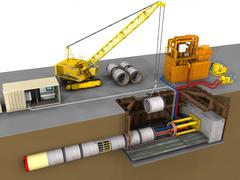
|
Today, the installation of gas, water and wastewater pipelines is still predominantly carried out using open trenches. In view of the numerous disadvantages associated with this method, it is imperative that trenchless pipeline construction be considered much more strongly in the future than it has been to date as an alternative in the planning and construction of sewers and pipelines. This module deals in detail with the procedure and the various components. Emphasis is placed on the different types of shield machines, excavation tools, separation systems, the control and steering station, injection/grouting agent and soil extraction and reprocessing. After completing this module, you will have a sound knowledge of: - all components of pipe jacking and
- their function and tasks.
|
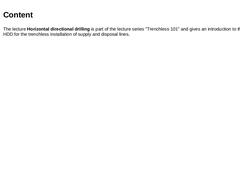
|

The lecture Horizontal directional drilling is part of the lecture series "Trenchless 101" and gives an introduction to the topic of HDD for the trenchless installation of supply and disposal lines. |
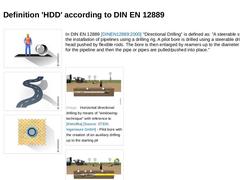
|

| (Image: Unmanned techniques) | | (Image: Steerable techniques) | | (Image: Soil removal techniques) |
| In DIN EN 12889 [DINEN12889:2000] "Directional Drilling" is defined as: "A steerable system for the installation of pipelines using a drilling rig. A pilot bore is drilled using a steerable drilling head pushed by flexible rods. The bore is then enlarged by reamers up to the diameter required for the pipeline and then the pipe or pipes are pulled/pushed … |
|
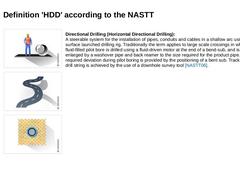
|

|
(Image: Unmanned techniques)
|
|
(Image: Steerable techniques)
|
|
(Image: Soil removal techniques)
|
|
Directional Drilling (Horizontal Directional Drilling):
A steerable system for the installation of pipes, conduits and cables in a shallow arc using a surface launched drilling rig. Traditionally the term applies to large scale crossings in which a fluid-filled pilot bore is drilled using a fluid-driven motor at the end of a bend-sub, and is then enlarged … |
|
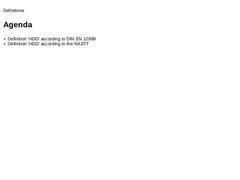
|

|
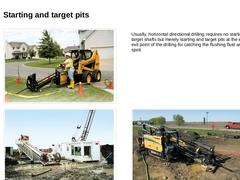
|

| (Image: Add-on systems - Mini drill rig (CASE 300 CM) with 56 kN pulling force mounted to a compact loader [FI-Case])
|
Usually, horizontal directional drilling requires no starting and target shafts but merely starting and target pits at the entry and exit point of the drilling for catching the flushing fluid and the spoil. | | (Image: Mega boring rig at construction site [FI-Herreb])
| (Image: Drill rig at construction site [FI-Vermea])
|
|
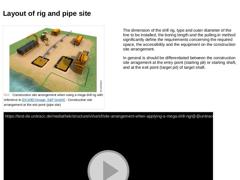
|

(Image: Construction site arrangement when using a mega drill rig with reference to [DCA95] [Image: S&P GmbH] - Construction site arrangement at the exit point (pipe site)) The dimension of the drill rig, type and outer diameter of the line to be installed, the boring length and the pulling.in method significantly define the requirements concerning the required space, the accessibility and the equipment on the construction site arrangement. In general … |

|

|
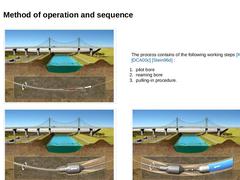
|

| (Image: Working steps for horizontal directional drilling (underground crossing of a river) with reference to [DCA01] [Image: S&P GmbH] - Pilot bore)
|
The process contains of the following working steps [Kleis96a] [DCA00c] [Stein96d] : - pilot bore
- reaming bore
- pulling-in procedure.
| | (Image: Working steps for horizontal directional drilling (underground crossing of a river) with reference to [DCA01] [Image: S&P GmbH] - Reaming bore)
| (Image: Working … |
|
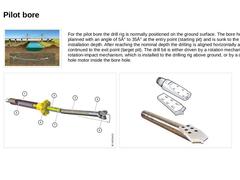
|

| (Image: Working steps for horizontal directional drilling (underground crossing of a river) with reference to [DCA01] [Image: S&P GmbH] - Pilot bore)
For the pilot bore the drill rig is normally positioned on the ground surface. The bore hole is planned with an angle of 5° to 35° at the entry point (starting pit) and is sunk to the planned installation depth. After reaching the nominal depth the drilling is aligned horizontally and is continued … |
|
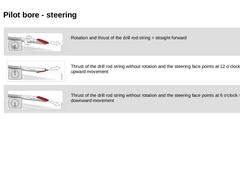
|

| | (Image: Rotation and thrust of the drill rod string = straight forward)
Rotation and thrust of the drill rod string = straight forward | | (Image: Thrust of the drill rod string without rotation and the steering face points at 12 o'clock = upward movement)
Thrust of the drill rod string without rotation and the steering face points at 12 o'clock = upward movement | | (Image: Thrust of the drill rod string without rotation and the steering face points at … |
|
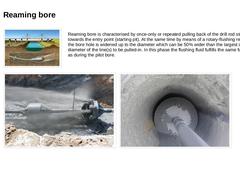
|

| (Image: Working steps for horizontal directional drilling (underground crossing of a river) with reference to [DCA01] [Image: S&P GmbH] - Reaming bore)
Reaming bore is characterised by once-only or repeated pulling back of the drill rod string towards the entry point (starting pit). At the same time by means of a rotary-flushing reamer the bore hole is widened up to the diameter which can be 50% wider than the largest outer diameter of the line(… |
|
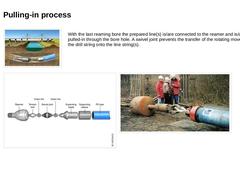
|

| (Image: Working steps for horizontal directional drilling (underground crossing of a river) with reference to [DCA01] [Image: S&P GmbH] - Pulling-in process)
With the last reaming bore the prepared line(s) is/are connected to the reamer and is/are pulled-in through the bore hole. A swivel joint prevents the transfer of the rotating movement of the drill string onto the line string(s). | |
(Image: Structure and view of an expanding pulling head (without … |
|
|
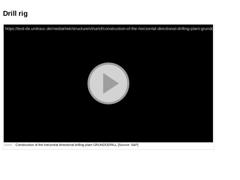
|

(Video: Construction of the horizontal directional drilling plant GRUNDODRILL) |
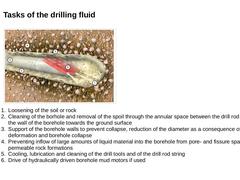
|

| (Image: Tasks of the drilling fluid)
| - Loosening of the soil or rock
- Cleaning of the borhole and removal of the spoil through the annular space between the drill rod and the wall of the borehole towards the ground surface
- Support of the borehole walls to prevent collapse, reduction of the diameter as a consequence of plastic deformation and borehole collapse
- Preventing inflow of large amounts of liquid material into the borehole from pore- and fissure …
|
|
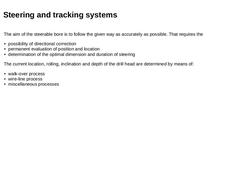
|

|
The aim of the steerable bore is to follow the given way as accurately as possible. That requires the - possibility of directional correction
- permanent evaluation of position and location
- determination of the optimal dimension and duration of steering
The current location, rolling, inclination and depth of the drill head are determined by means of: - walk-over process
- wire-line process
- miscellaneous processes
|
|
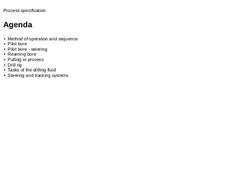
|

|
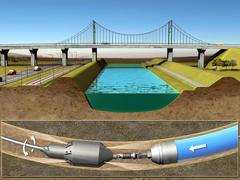
|

This lecture is part of the series "Trenchless 101" and serves to provide an overview of horizontal directional drilling (HDD). |
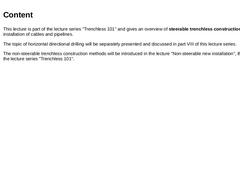
|

This lecture is part of the lecture series "Trenchless 101" and gives an overview of steerable trenchless construction methods for installation of cables and pipelines. The topic of horizontal directional drilling will be separately presented and discussed in part VIII of this lecture series. The non-steerable trenchless construction methods will be introduced in the lecture "Non-steerable new installation", the sixth part of the lecture series "Trenchless … |
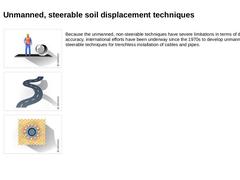
|

|
(Image: Unmanned techniques)
|
|
(Image: Steerable techniques)
|
|
(Image: Soil displacement techniques)
|
|
Because the unmanned, non-steerable techniques have severe limitations in terms of directional accuracy, international efforts have been underway since the 1970s to develop unmanned steerable techniques for trenchless installation of cables and pipes. |
|
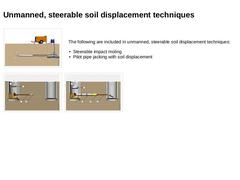
|

| (Image: Soil displacement technique - steerable impact moling)
|
The following are included in unmanned, steerable soil displacement techniques: - Steerable impact moling
- Pilot pipe jacking with soil displacement
| |
(Image: Creating the pilot boring in the soil displacement technique with reference to [Stein89g] [Image: S&P GmbH] - Extending the pilot displacement and steering head)
|
(Image: Expansion boring in the soil displacment technique with reference … |
|
|
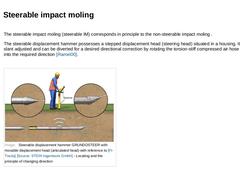
|

| The steerable impact moling (steerable IM) corresponds in principle to the non-steerable impact moling . The steerable displacement hammer possesses a stepped displacement head (steering head) situated in a housing. It can be slant adjusted and can be diverted for a desired directional correction by rotating the torsion-stiff compressed air hose by hand into the required direction [Ramei00]. (Image: Steerable displacement hammer GRUNDOSTEER with movable … |
|
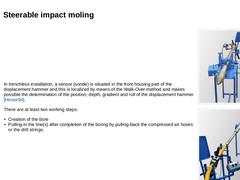
|

|
In trenchless installation, a sensor (sonde) is situated in the front housing part of the displacement hammer and this is localized by means of the Walk-Over method and makes possible the determination of the position, depth, gradient and roll of the displacement hammer [Hesse94]. There are at least two working steps: - Creation of the bore
- Pulling-in the line(s) after completion of the boring by pulling-back the compressed air hoses or the drill strings.
|
|
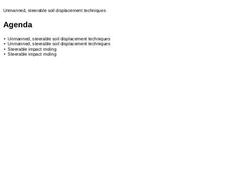
|

|
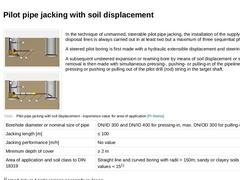
|

|
(Image: Creating the pilot boring in the soil displacement technique with reference to [Stein89g] [Image: S&P GmbH] - Extending the pilot displacement and steering head)
|
|
(Image: Expansion boring in the soil displacment technique with reference to [Stein89g] [Image: S&P GmbH] - Extending the expander)
|
|
In the technique of unmanned, steerable pilot pipe jacking, the installation of the supply and disposal lines is always carried out in at least … |
|